Broken Hill, New South Wales
| Broken Hill New South Wales |
|||||||
Broken Hill seen from the "Line of Lode" monument |
|||||||
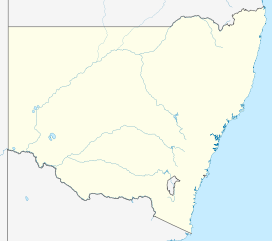 Broken Hill
|
|||||||
| Population: | 18,854 [1] | ||||||
| Postcode: | 2880 | ||||||
| Elevation: | 315 m (1,033 ft) | ||||||
| Time zone:
• Summer (DST) |
ACST (UTC+9:30)
ACDT (UTC+10:30) |
||||||
| Location: | |||||||
| LGA: | City of Broken Hill | ||||||
| County: | Yancowinna | ||||||
| State District: | Murray-Darling | ||||||
| Federal Division: | Farrer | ||||||
|
|||||||
Broken Hill is an isolated mining city in the far west of outback New South Wales, Australia. The world's largest mining company, BHP Billiton, has roots in the town.
Broken Hill is located near the border with South Australia on the crossing of the Barrier Highway (national route 32) and the Silver City Highway (national route 79), in the Barrier Range. It is 220 m (722 ft) above sea level, an average rainfall of 235 mm (9 in) and summer temperatures that reach well over 40 °C (104 °F). The closest major city is Adelaide, the capital of South Australia, which is more than 500 km (311 mi) to the southwest. Unlike the rest of New South Wales, Broken Hill (and the surrounding region) observes Australian Central Standard Time, UTC+9:30, a time zone it shares with South Australia and the Northern Territory.
Broken Hill has been called The Silver City, the Oasis of the West, and the Capital of the Outback. Although over 1,100 km (684 mi) west of Sydney, and surrounded by semi-desert, the town still manages colourful park and garden displays, and offers a number of attractions.
Contents |
Origins of town name
Broken Hill is Australia's longest-lived mining city. In 1844, the explorer Charles Sturt saw and named the Barrier Range, and at the time referred to a "Broken Hill" in his diary.[2] Silver ore was later discovered on this broken hill in 1883 by a boundary rider named Charles Rasp. The "broken hill" that gives its name to Broken Hill actually comprised a number of hills that appeared to have a break in them. The broken hill no longer exists, having been mined away.

Geology
Broken Hill's massive orebody, which formed about 1,800 million years ago, has proved to be among the world's largest silver-lead-zinc mineral deposits. The orebody is shaped like a boomerang plunging into the earth at its ends and outcropping in the centre. The protruding tip of the orebody stood out as a jagged rocky ridge amongst undulating plain country on either side. This was known as the broken hill by early pastoralists. Miners called the ore body the Line of Lode. A unique mineral recently identified from Broken Hill has been named Nyholmite [3] after one of the city's famous sons Ron Nyholm (1917–1971)[4].
Economy
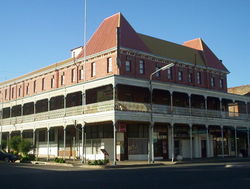
Broken Hill has been and still is a town dominated by the mining industry. The mines founded on the Broken Hill Ore Deposit - the world's richest lead-zinc ore body - have until recently provided the majority of direct employment and indirect employment in the city. The Broken Hill Proprietary Company became Australia's largest mining company, and later became part of the world's largest mining company, BHP Billiton.
In the past, before the 1940s, mining was achieved via hand with high labor utilisation rates and included horse-drawn carts underground. The advent of diesel powered mining equipment in the late 1940s and the move toward mechanised underground mining has resulted in lower labor utilisation per tonne of ore recovered, and this has seen the workforce in the mines shrink. Another factor in the shrinking of workforce size has been the consolidation of mining leases and operators, from several dozen to just two main operators at present.
While the labor force has been in decline due to the low metal prices of the 1990s, which saw the failure of miner Pasminco Ltd, recent resurgence in metal prices has returned the sole existing operator, Perilya Limited, to profitability and prompted Consolidated Broken Hill Limited to advance development of the previously unmined Western Lodes and Centenary Lodes. This has involved creation of over 70 jobs during development and will see a second, new, milling operation built within the town. Although the mining industry is resurgent, labor utilisation will remain low.
Due to its exposure to the vagaries of the mining industry, and because of a swiftly shrinking population, similar to other rural centres, and compounded by its isolation, Broken Hill has actively encouraged its artistic credentials and is promoting itself as a tourism destination in order to become less reliant upon mining as a source of employment.
Demographics
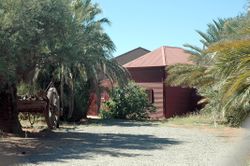
Broken Hill's population has shrunk by one third since the heyday of the 1970s zinc boom, with the decrease attributed to migration from the closure and consolidation of mining operations.[5] In 1933 Broken Hill, with a population of 26,925, was the third largest urban incorporated area in New South Wales.[6]
The impact on Broken Hill's economy of the shrinking mining industry and the more efficient mining rates resulted in a higher proportion of part-time employment, higher employment participation rate by females, a general reduction in overall household incomes, and an increase in the average age of people in Broken Hill as the young move away for work.
Broken Hill has always had a small indigenous community. In recent years the proportion of the population identifying as Aboriginal has increased markedly; from 0.6% in 1971 to 5.1% in 2004.
In the 19th and early 20th century Broken Hill was home to a community of Afghans. Afghans worked as camel drivers in many parts of outback Australia, and they made a significant contribution to economic growth at a time when transport options were limited. The camel drivers formed the first sizeable Muslim communities in Australia, and in Broken Hill they left their mark in the form of the first mosque in NSW (1891).
Media
- Barrier Daily Truth - Local Newspaper
Major Metropolitan and National Newspapers from Adelaide, Sydney and Melbourne are available in Broken Hill.
Local Radio Stations that are available in the Broken Hill region include:
2DRY FM - 107.7FM - community radio station
Radio 1656 AM - Independent Local Radio
ABC Local Radio - 999 AM (NB: ABC Local Radio`s national and state-wide programming is received from Adelaide instead of Sydney when the Broken Hill studios are not broadcasting local programming.)
Triple J (ABC) - 102.1 FM
ABC Radio National - 102.9 FM
ABC Classic FM - 103.7 FM
ABC NewsRadio - 104.5 FM
2BH Commercial Radio - 567 AM
Hill FM Commercial Radio - 96.5 FM
Hype FM - 87.6 FM
The following television channels are available free-to-air in the Broken Hill region.
ABC which broadcasts the ABC1, ABC2 (digital only), ABC3 (digital only) and ABC News 24 channels.
SBS broadcasting the SBS ONE and SBS Two (digital only) channels.
Southern Cross GTS/BKN (formerly "Central Television".)
Southern Cross Ten.
Although Broken Hill is in New South Wales, the programming schedules for these channels is the same as Channel Nine, Channel Ten and Channel Seven in Adelaide, with local commercials inserted and some variations for coverage of Australian Football League or National Rugby League matches, local and national news and current affairs programs, some lifestyle and light entertainment shows and infomercials.
Southern Cross GTS/BKN primarily broadcasts Seven Network programming plus some Nine Network output, mainly AFL, NRL, cricket and some other sporting and major events, with Channel Nine programming often delayed to make way for Seven output. Southern Cross Ten broadcasts Network Ten output and some programming from the ONE HD sports channel.
The Southern Cross Central service (unrelated to the original Central GTS/BKN) and Imparja Television are available via satellite and terrestrial transmission in the adjacent areas.
History
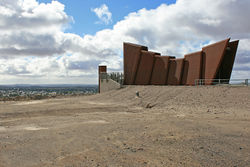
The earliest human settlers in the area around Broken Hill are thought to be the Wiljakali[2] Aborigines, although this was probably only intermittent due to lack of permanent water sources. As in much of Australia, a combination of disease and aggression by white settlers drove them from their lands.[7]
The first European to visit the area was the then Surveyor General of New South Wales, Major Thomas Mitchell, in 1841. Three years later, in 1844, the explorer Charles Sturt saw and named the Barrier Range while searching for an inland sea; the range was so named as it was a barrier to his progress north. Burke and Wills passed through the area in their famous 1860-61 expedition, setting up a base camp at nearby Menindee. Pastoralists first began settling the area in the 1850s, with the main trade route to the area along the Darling River.[2]
Broken Hill itself was founded in 1883 by a boundary rider called Charles Rasp who patrolled the Mount Gipps fences. In 1883 he discovered what he thought was tin but when the samples came back they were instead silver and lead and the ore body they came from became the largest and richest of its kind in the world. The Broken Hill Proprietary Company (BHP) (later BHP Billiton) was founded by the Syndicate of Seven to mine the ore body of Broken Hill in 1885. However by 1915 BHP realised its ore reserves were limited and began to diversify into steel production and on 28 February 1939 mining at the BHP mines at Broken Hill had ceased.
However BHP was by no means the only miner at Broken Hill and mining continued at the southern and northern ends of the Line of Lode. Currently the southern and northern operations are run by Perilya Limited who plan to open further mines along the Line of Lode.
The Battle of Broken Hill took place on New Year's Day 1915 when two men fired upon a trainload of picnickers in a self-described attack on the British Empire. Since, at that time, Australia was preparing to attack the Ottoman Empire, those people were first speculated to be Turkish, but later identified as being from British colony of India (modern day Pakistan).[8][9] They killed four and wounded six, before they were killed by a group of policemen and soldiers.[10]
It is also known for its input into the formation of the labour movement in Australia, and has a rich trade union history. Some of the most bitter industrial disputes have been fought in Broken Hill in 1892, 1909 and 1919. The last of these led to the formation in 1923 of the Barrier Industrial Council, a group of 18 trade unions, which became one of the most influential organisations in the politics of the city.
Like many "outback" towns, Broken Hill was built on precious metals, having once had the world's richest deposits of lead, zinc and silver. Although now depleted somewhat, mining still yields around two million tonnes annually. Some mine tours are available. Sheep farming is now one of the principal industries in the area and there are considerably more sheep than people — almost 2 million Merino sheep.
On 10 January 2007, the Broken Hill City Council was dismissed by the New South Wales Minister for Local Government following a public inquiry.
Railways
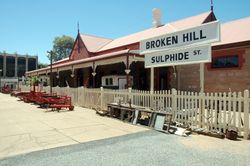
The city's isolation was a big problem until the Adelaide narrow gauge railway link was finished in 1888. Since the New South Wales Government would not allow the South Australia Government to build a railway to cross the border, the last 19 miles (30 km) was built by a private company as the Silverton Tramway.[11] The line was so named because it was originally intended to serve the mining town of Silverton, but by the time the railway reached the town it was already being eclipsed by the newer and bigger mine at Broken Hill.[12] The main purpose of the railway was to transport concentrates and ores from the mines to the smelters and port facilities on the coast at Port Pirie, SA. As a backload to Broken Hill it transported supplies, principally coal for boilers at the mines and timber for the timber sets used underground in mining. The Silverton Tramway was owned by Broken Hill mining interests.
The main sidings and locomotive servicing facilities were located in Railwaytown, a suburb of Broken Hill with sidings running to the south and north to serve the mines. The main passenger station was at Sulphide Street.
From the later 1890s, Broken Hill Council campaigned for a tramway to provide public transport around the town and to the mines. Eventually the NSW Government decided to build a tramway which was officially opened on 19 March 1902. It was run by steam trams transferred from Sydney by sea and then by rail across South Australia. It was a curious operation which after World War I suffered increasingly bad losses until the New South Wales Government closed the system in December 1926.
Another curiosity was the Tarrawingee Tramway which was a narrow gauge railway line which ran north from Broken Hill for about 40 miles (64 km) to an area of limestone deposit which was quarried and transported to Broken Hill for use in the smelters at the mines.[13] The tramway opened in 1891 but closed in 1898 as the smelters moved to Port Pirie. In 1889 the Public Works Committee of the New South Wales Legislative Assembly recommended that the Government take over the line and it subsequently became a narrow gauge part of the New South Wales Government Railways (NSWGR) run under contract by Silverton Tramway.
It was an excursion train on the Silverton Tramway that was fired on by two immigrants in 1915 (see Battle of Broken Hill).
In 1919, a 4 foot 8½ inch (1435 mm) standard gauge rail link from Broken Hill to Menindee was opened as the first stage in a planned direct route to Sydney. The terminus for the train was at Crystal Street station, some distance from the Silverton Tramway's Sulphide Street station. The railway mainly hauled water from the Darling River. The rolling stock all had to be transported by sea to South Australia and the railway was supervised by the superintendent of the Broken Hill Tramways.
In November 1927 the direct link to Sydney was completed. In September 1937 the NSWGR placed into service the Silver City Comet, an air conditioned rail car which ran between Broken Hill and Parkes.
During World War II land transportation between South Australia and Eastern Australia became important with the threat posed by submarines and mines to coastal shipping. Extensive transshipment yards were constructed at Broken Hill in 1942 to allow transshipment of munitions. However in the event the threat was never fully realised.
With the purchase of the Sulphide Corporation by the Zinc Corporation in 1948 a modern zinc smelter was constructed at Cockle Creek, south of Newcastle. This started to take lead and zinc concentrates directly from Broken Hill in the 1960s via rail marking the first major use of the rail link to NSW. This was the well known W44 Concentrate Train.
In 1970 the 3 foot 6 inch (1067 mm) gauge railway from Port Pirie to Broken Hill was converted to a 4 foot 8½ inch (1435 mm) gauge, thus completing the standard transcontinental gauge line from Sydney to Perth.
Water
In the early days there was a severe water shortage and the mines and the people fought for water, so they would ship water on trains from the Darling River until 1952, when Broken Hill's demands for a permanent water supply were met with the completion of the pipeline to Stephen's Creek. Dams on the Darling River channel water to Broken Hill, making it an oasis amid the harsh climate and topography of the Australian outback.
Electric power
By the 1920s most of the nine mines on the Line of Lode had their own steam powered electrical generators to power the surface and underground workings. As Broken Hill is in a desert with little water and virtually no fuel steam generation was an expensive option. In 1927 a plan for a central power generating facility was proposed by F. J. Mars, consulting electrical engineer with the Central Mine. The proposed powerhouse would generate electricity and compressed air. The mines agreed and formed Western New South Wales Electric Power Pty. Ltd. to construct and run the plant. The powerhouse was completed in 1931 and was diesel powered. This was one of the earliest examples of the use of diesel power generation in Australia. The plant was enlarged in 1950 to cope with increased demand from the North Mine. At the same time, a new power station run by the Southern Power Corporation (owned by Consolidated Zinc) was erected near the new Broken Hill Consolidated Mine to provide power to the southern end of the Line of Lode. Both stations were connected as a grid.
A HVDC back-to-back station with a maximum transmission rate of 40 megawatts was built at Broken Hill in 1986. It consists of 2 static inverters working with a voltage of 8.33 kV. After this station was operational the two other power stations closed and their equipment was gradually removed.
Attractions
Broken Hill and the surrounding area has many natural and man-made attractions on offer for the tourist. These include mining operations (some open to the public), a visitor's centre and lookout on top of the original Line of Lode mine, historic buildings, town history walking trails, many resident artists and galleries, the Sculpture Symposium, COBB & Co coach & wagon rides, Silverton Camel Farm, Stephen's Creek, several quarries, lakes, the Mundi-Mundi plains, and terrific sunsets.
Broken Hill is a major base for both the Royal Flying Doctor Service of Australia and School of the Air. The Pro Hart Gallery and Sculpture Park contains a large collection of the noted Australian artist Kevin 'Pro' Hart's paintings and sculptures, as well as many artistic works of others that Hart collected during his lifetime. The gallery also features the Rolls Royce that he painted in his unique style.
Surprisingly, for a town with such a small population, Broken Hill has a burgeoning nightlife. Many clubs exist and are open most nights of the week until late. Establishments catering to both locals and tourists include the Musician's Club and the Democratic Club.
Additionally, Broken Hill, its nearby neighbour Silverton, and the surrounding desert have served as the backdrop for shooting numerous movies, television programs, video-clips and commercials. The clear blue skies and the magic light feature in movies including Mad Max 2 (a.k.a. The Road Warrior) and The Adventures of Priscilla, Queen of the Desert. Mario's Palace, currently closed, had the "tack-o-rama" mural that was featured in The Adventures of Priscilla, Queen of the Desert.
Visitors to the town are often fascinated by the houses built with corrugated iron walls. Although corrugated iron is widely used as a roofing material throughout Australia, it is not commonly used for walls in houses.
Because of its rich historic heritage, the City of Broken Hill has been nominated for listing on the Commonwealth National Heritage list (the highest level of heritage protection in Australia) and the nomination will be assessed in 2007 and 2008.
Transport
Broken Hill is one of the stops of the Indian Pacific passenger service, operated by the Great Southern Railway, from Sydney in New South Wales to Perth in Western Australia via Adelaide in South Australia. Great Southern Railway also operates The Ghan from Adelaide to Darwin in the Northern Territory and The Overland from Adelaide to Melbourne. The weekly CountryLink Xplorer service between Broken Hill and Sydney, which was introduced in 2005, arrives from Sydney on Mondays at 19:33, departing Broken Hill on Tuesdays at 7:45 for the return to Sydney. Regional Express operates air services from Broken Hill Airport to and from Adelaide, Dubbo, and Sydney.
| Preceding station | NSW Main lines | Following station | ||
|---|---|---|---|---|
| Terminus | Broken Hill Line |
Mount Gipps
towards Orange
|
||
| Preceding station | CountryLink | Following station | ||
| Terminus | CountryLink Western
Broken Hill Outback Xplorer
|
Menindee
towards Sydney
|
||
| Great Southern Railway | ||||
|
Peterborough
towards East Perth
|
Indian Pacific |
Menindee
towards Sydney
|
||
Climate
Broken Hill has a desert climate (BWk) under the Köppen climate classification. Winter in Broken Hill can be very cold and dry, while summers are highly variable — mostly hot and dry. The average maximum during the summer months (November to March) is about 32 °C (90 °F) with an average of 25% humidity, although occasional rainfall and cooler weather exist. Dust storms are a common problem in the desert but the people of Broken Hill created reserves to surround the town thus protecting the town from the worst of the storms.
| Climate data for Broken Hill | |||||||||||||
|---|---|---|---|---|---|---|---|---|---|---|---|---|---|
| Month | Jan | Feb | Mar | Apr | May | Jun | Jul | Aug | Sep | Oct | Nov | Dec | Year |
| Average high °C (°F) | 32.7 (90.9) |
32.2 (90) |
29.0 (84.2) |
23.9 (75) |
19.2 (66.6) |
15.6 (60.1) |
15.1 (59.2) |
17.3 (63.1) |
21.0 (69.8) |
24.9 (76.8) |
28.6 (83.5) |
31.4 (88.5) |
24.2 (75.6) |
| Average low °C (°F) | 18.4 (65.1) |
18.2 (64.8) |
15.5 (59.9) |
11.8 (53.2) |
8.6 (47.5) |
6.2 (43.2) |
5.3 (41.5) |
6.3 (43.3) |
8.8 (47.8) |
11.7 (53.1) |
14.7 (58.5) |
17.1 (62.8) |
11.9 (53.4) |
| Precipitation mm (inches) | 23.7 (0.933) |
24.1 (0.949) |
19.4 (0.764) |
17.6 (0.693) |
22.7 (0.894) |
21.5 (0.846) |
18.9 (0.744) |
18.6 (0.732) |
20.5 (0.807) |
24.6 (0.969) |
19.9 (0.783) |
21.5 (0.846) |
253.1 (9.965) |
| Source: [14] | |||||||||||||
Notable people from Broken Hill
- Eric Minchin - artist and founder of the "Brushmen of the Bush"
- Steve Abbott - comedian
- Jack Absalom - artist
- Tom Black - Poet
- Trevor Butler - Big Brother Australia 2004 winner
- June Bronhill - soprano opera singer, whose adopted (stage) surname is a contraction of the name of her hometown
- Steve Cropley - editor in chief, Autocar magazine
- Barbara De Franceschi - poet
- Ion Idriess - novellist
- Rae Desmond Jones - poet and novellist
- Stewart Finlay-McLennan - Actor
- "Lord Tim" Grose - heavy metal musician
- Pro Hart - artist
- Susan Dorothea White - artist
- Prof Sir Ronald Sydney Nyholm - Chemist and teacher
- Sir Maurice Alan Mawby - Metallurgist & initiator with Albert Morris of 'the green belt' to regenerate flora and fauna around the mines[15]
- Albert Morris - assayist & naturalist
- Don F Fairweather - Mine Manager, Leader, supporter of Aboriginal Affairs and Musician [16]
- Chips Rafferty - actor
- Stephen Rowe - singer/songwriter
- Nikki Visser - model and actor
- Murray Farquhar - NSW Chief Stipendiary Magistrate (1971–1977)
- Taylor Walker - Adelaide Crows player
- Marvis Sofield - poet
- Brent Staker - Brisbane Lions player (Former West Coast Eagles player)
- Dean Solomon - Fremantle Dockers player
- Korey Menz - Creator of the candy Fruchocs

See also
- Spirits of the Air, Gremlins of the Clouds, 1989 film shot in Broken Hill
References
- ↑ Australian Bureau of Statistics (25 October 2007). "Broken Hill (Urban Centre/Locality)". 2006 Census QuickStats. http://www.censusdata.abs.gov.au/ABSNavigation/prenav/LocationSearch?collection=Census&period=2006&areacode=UCL114000&producttype=QuickStats&breadcrumb=PL&action=401. Retrieved 29 November 2007.
- ↑ 2.0 2.1 2.2 "History." Broken Hill: Accessible Outback. 2007, Edition 15, p4.
- ↑ "Description and crystal structure of nyholmite, a new mineral related to hureaulite, from Broken Hill, New South Wales, Australia". http://minmag.geoscienceworld.org/cgi/content/abstract/73/5/723. Retrieved 3 February 2010.
- ↑ "Ronald Sydney Nyholm". http://en.wikipedia.org/wiki/Ronald_Sydney_Nyholm. Retrieved 3 February 2010.
- ↑ "NSW Department of Health Broken Hill Review 2004". http://www.health.nsw.gov.au/pbh/pdf/brokenhill.pdf. Retrieved 7 March 2006.
- ↑ 1938 Australian Year Book
- ↑ "Silverton". The Sydney Morning Herald. 8 February 2004. http://www.smh.com.au/news/New-South-Wales/Silverton/2005/02/17/1108500198942.html. Retrieved 17 December 2007.
- ↑ "Battle of Broken Hill: Ron visits this Outback area of New South Wales". http://www.abc.net.au/gnt/history/Transcripts/s1051016.htm. Retrieved 25 July 2008.
- ↑ "Of Art and War on Broken Hill". http://www.travelintelligence.com/travel-writing/1000030/Australasia/Australia/New-South-Wales/Broken-Hill/Of-Art-and-War-on-Broken-Hill.html. Retrieved 25 July 2008.
- ↑ "Battle of Broken Hill". http://www.postcards.sa.com.au/features/battle_broken_hill.html. Retrieved 16 November 2006.
- ↑ "A History of Rail in South Australia". National Railway Museum Port Adelaide. http://www.natrailmuseum.org.au/common/nrm_a01_index.html. Retrieved 5 March 2008.
- ↑ "Silverton Tramway Company Ltd". NSW Parliament. http://www.parliament.nsw.gov.au/Prod/Parlment/HansArt.nsf/V3Key/LC20040226014. Retrieved 5 March 2008.
- ↑ "Tarrawingee Line". http://www.nswrail.net/lines/show.php?name=NSW:tarrawingee. Retrieved 22 October 2006.
- ↑ "Climate statistics for Broken Hill". Australian Bureau of Meteorology. http://www.bom.gov.au/climate/averages/tables/cw_047007.shtml. Retrieved 12 February 2009.
- ↑ "Mawby Sir Maurice Alan". http://adbonline.anu.edu.au/biogs/A150394b.htm. Retrieved 23 July 2010.
- ↑ "Donald Frederick Fairweather". http://www.mininghall.com/MiningHallOfFame/HallOfFameDatabase/Inductee.php?InducteeID=1230. Retrieved 23 July 2010.
Further reading
- Railed Transport in the Broken Hill District Singleton, C.C. Australian Railway Historical Society Bulletin, April; May; June; July; August 1962
External links
|
||||||||||||||||||||||||||